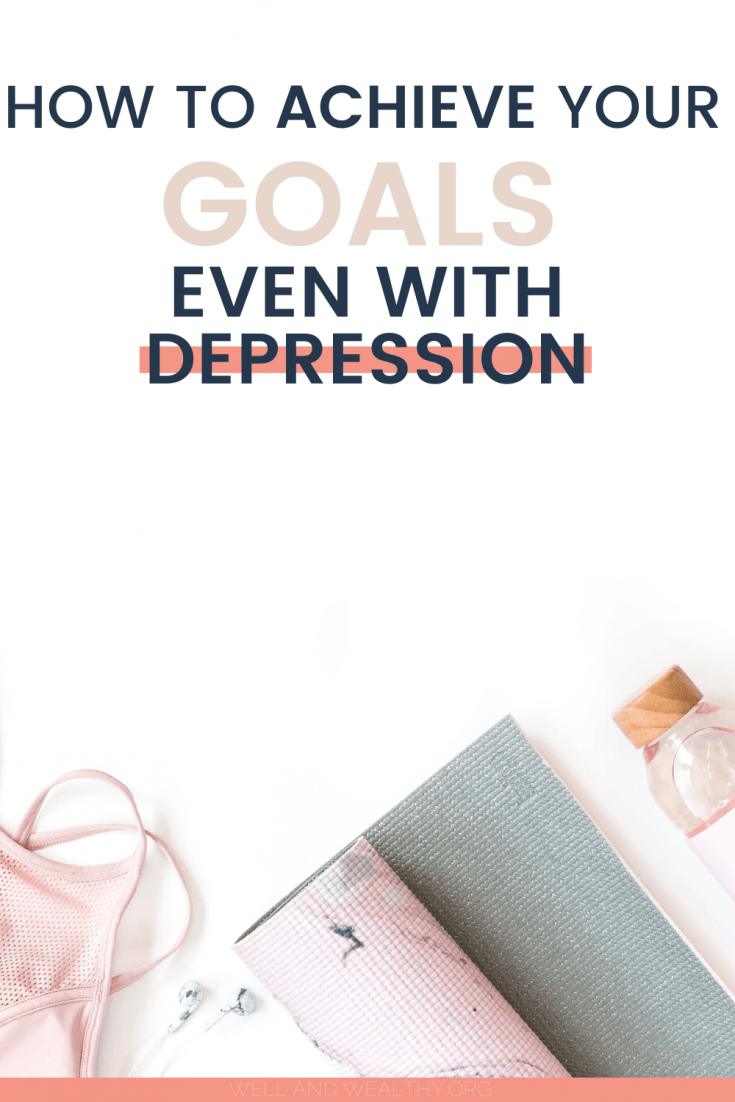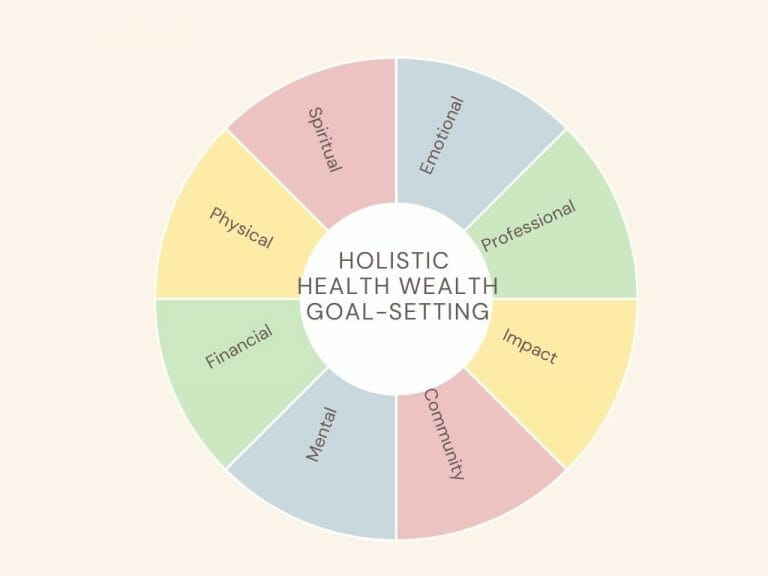How to Achieve Your Goals Step By Step

If you’ve ever wondered how to achieve absolutely any goal, even if you’re dealing with mental health challenges like depression, then you’re in the right place. This post is tailor-made for you.
I’m guessing you clicked on this post because you are fed up with setting goals but not achieving them.
You know how to reach your goal, you know the actions associated with it, and you’re probably almost a mini expert on the subject, and yet you are still not reaching that goal.
But luckily today, I’m going to take you through a goal-setting process that really works. This simple framework allowed me to reach a ton of goals even when my depression was at its worst.
As an affiliate partner of various brands and sponsored content, we may earn commission on qualifying purchases. Disclaimer | Advertise With Us
Proof this goal-reaching system works
However, right now I am cringing because I’m going to list out all the main goals I accomplished, not to brag but because you need to know that I can walk the walk and not just talk the talk.
So, in no particular order, a few of the things I accomplished whilst my depression was at its worst and whilst I was in recovery from depression, were:
It was my and my boyfriend’s first-ever home. Neither of us had ever done any renovations, the most experience I had was watching my parents as a kid.
That was a massive project, but we got there in the end and I adore our house now.
My goodness, that was a learning curve. Who knew so much goes into running and starting a blog?
But now I get multiple thousands of people coming here each month and I have lots of people on my email list, all of whom I’m able to help which is just incredible.
Also, the final goal I achieved that I’m listing out is I (now don’t laugh) completed a “Couch to 5K” which, yes, I know, a lot of people can run 5K without even blinking. I get that.
But running has always been my nemesis and the fact that I even managed it whilst I had depression, which being motivated to do anything when you have depression is bloody impressive. So I’m very, very proud of this last one.
As you can see this goal-achieving process is one that works, so I’m super excited to share it with you!
But first, we need to talk about SMART Goals
This goal-achieving process is loosely based on the SMART goals formula, which you made have heard of…
The SMART goal system is okay, but I find it kind of stuffy and boring, and there are quite a few things it misses out.
The SMART stands for specific, measurable, achievable, realistic and timely. I won’t bore you by going into detail on what each one really means, suffice to say the process I’m about to take you through covers them all and then some without you needing to learn a corporate-sounding acronym.
How to Achieve Your Goals, Step-By-Step
Step One – Come up with a clear goal
Sounds obvious, right?
But the problem with goal-setting a lot of the time is we’ll set something like, “I want to get healthy” and then that’s the goal.
Well, that doesn’t mean anything.
Like getting healthy could mean eating less carbs if you feel your carb intake is too high. It could mean starting running. You might not be talking about physical health at all, you might be referring to mental health.
So unless we get specific and ultra-clear on our goal then it’s fundamentally meaningless.
I mean, how would you even know when you’ve “gotten healthy?” You wouldn’t, you’d have no idea.
So we need to come up with a clear goal.
Getting healthy is a great jumping-off point, but think about it, what does getting healthy mean to you?
Does that mean upping your physical fitness? Does that mean improving your mental health? Hone in really on what that means to you and make that your goal.
And then the next part of this is to make sure the goal you’re setting is a goal you can achieve rather than a desired side-effect.
Step Two – Come up with a timeline or a deadline for your goal
It can feel a little counterintuitive to set a deadline or timeline.
However, we must give a small enough deadline now so if the goal is too big to fit into that deadline then we can deal with it early on rather than way down the goal-setting process.
I recommend you don’t have a goal deadline/timeline longer than three months.
Three months max is perfect. It leaves you plenty of time to actually do some actions that’ll can have massive results, but it’s not so long that you are like, “Oh, I can’t see the end of that, ugh, I’m giving up.”
If you have a goal that’s going to take longer than three months don’t try and cram it in! Split it into smaller goals with timelines no longer than three months.

Step Three – Figure out how you’re going to track your goal
This will vary per goal and could be easier for some goals than others.
Let’s say you want to improve your cooking and your goal is to learn a three-course meal recipe by heart and cook it up for friends.
You have the ultimate “Have I reached the goal? Can I do the thing? Can I serve up a three-course dinner for my friends from scratch, from my head, no recipe?”
You can track that, but you’re also going to want to be tracking throughout.
That could be you doing three hours of cooking practice each week and you log those hours so you have a clear record that you’ve been achieving your goal.
This is so important because it really keeps you motivated.
You need to come up with a simple and easy system that works for you to track your goal. If you need any ideas check out habit trackers for bullet journals.
It might not be perfect for what you need, but they have some really amazing ones and it could give you the inspiration you need.
Step Four – Write down your “whys”
I do this a little bit differently than most.
A lot of people like to write down one, big why and they do a massive journaling session about it. But personally, I need an overwhelming list of “whys” rather than just one, even if I’ve gone super deep with it.
What I recommend is you brain-dump around 25 “whys”.
25 reasons why this goal is the best thing ever. They could be tiny, they could be big. And you can write paragraphs if you want, although I prefer to just do bullet points.
The idea is, you would look over that list if you ever feel like you want to give up and there will be such an overwhelming number of reasons why you should continue.
It becomes, “Why would I quit? It seems so counter-intuitive now I’ve read my whys.”
Do you see what I mean?
It needs to be an overwhelming list of reasons why you should keep going on this goal, so much so that it almost gives you FOMO (fear of missing out) at the idea of not reaching your goal!
However, one thing to say about “whys”.
Make sure these are internal “whys” as opposed to external “whys”.
Internal “whys” come from you and external “whys” comes from something outside of you, and unless your “whys” come from what you truly want they they’re just not going to motivate you.
Let’s say you want to get an A in your next exam.
An external why would be because your mother will be proud, but then that’s her wanting you to get an A not you. Why do YOU want to get an A?

Step Five – Write down all your limiting beliefs and come up with new truths
Limiting beliefs are things you think are truths that your brain created to protect you at another point in your life. It’s not the easiest concept to get your head around so we will go over an example.
Let’s go back to getting that A in your next exam.
You might have some limiting beliefs around that like, “Unless I study for forty-five thousand hours, I will never get the grade,” or, “I can’t get the grade. I’m too stupid.”
There might even be more subtle ones like, “If I study too much, then I’ll miss out on seeing my friends.”
All these things are affecting your ability to do the work to hit your goal.
Side note, obviously your goal wouldn’t be to get an A on the exam, it would be to study a certain number of hours or something along those lines because the A is the side-effect.
And you will likely have loads and loads of limiting beliefs.
“I’m too stupid to get an A.” “I don’t have the time to commit that much to studying.” “I’m too tired to do that much studying.” Blah, blah, blah.
Now, some might have some basis in truth but what we have to understand is that WE get to decide which are real and which are not, and I will be honest with you, most of them are B.S.
Sure they were useful in keeping you safe at one point in your life but they’re not serving you anymore, so it’s time to create some new truths that WILL serve you!
Maybe you have a limiting belief like, “I’m too stupid to get a good mark on this exam so there’s no point.”
Well, let’s change it and rewrite it because actually, that’s not true (I mean some pretty stupid people have got some pretty impressive marks just by putting the work in… Plus I bet you’re way cleverer that you’re giving yourself credit for!)
You could write something super positive like, “I am more than intelligent enough to get the grade I want on this exam.” Or if that feels too far-fetched to you, rewrite it into something more neutral, like”If I put the work in, I can achieve a good grade.”
The idea is to write down all your limiting beliefs and write down new truths for each one, and those new truths are going to become your affirmations that you will look at, read or listen to.
You can even record yourself saying them on the voice memo app on your phone. Listen multiple times per day until THAT is the truth you believe in.
That is such a powerful step because it’s so easy to start working on a goal, and then you just stop because those limiting beliefs overpower you.
Now if you want to take it a step further then you might want to try some manifestation.
When you go over your affirmations pause afterward and really focus on how it will feel when you reach your goal.
Imagine you reached your goal right then, what feelings would you be feeling?
You want to try and feel those exact feelings really hard.
Don’t worry about what your head is saying, even if it’s saying something like “You’ll never reach this goal.”. Just focus on your feelings.
This is so powerful, and it’s amazing for manifestation. It’s also really amazing for getting you in the mood to do the work for that goal as well.

Step Six – Create an action plan for your goal
You will want to grab a fresh sheet of paper for this step.
Write down every single action you will have to do to get this goal done.
And I mean every. single. action.
So if your goal is to complete the Couch to 5K Program then you would start by researching different Couch to 5K programs.
Then you might need to buy new running shoes, then you will need to download a Couch to 5K app.
And then you will do your first day of the program. And then you’ll do the second day.
There might be other things around that, but you see how I’m breaking it down into little tiny steps?
It’s not just, “Do the Couch to 5K program.”
No. We need to break it down to each tiny action step.
Once you’ve brain-dumped all the actions you can think of, have a look over your points and see if any of the steps give you feelings of anxiety or overwhelm.
If they do, break the action down even more.
Let’s say, for example, going to the shopping center and buying trainers gives you anxiety. You need to break it down into even smaller pieces so they sound almost stupid, but it’s breaking it down like this that takes out the overwhelm and gets rid of procrastination.
So it’s no longer ‘go to the shopping center to buy trainers’
It’s ‘get in the car’. Drive to the shopping center. Park your car. Buy a car parking ticket. Display the car parking ticket. Walk to the trainer shop. Look at the trainers available.
Do you see what I mean? Tiny, tiny steps.
It might look really stupid when you write it down, but on the basis you’re the only one who sees it so who cares? Especially when it works so well.
This is something you can do with anything in life that’s causing you to procrastinate because you’re so overwhelmed – break it down into tiny steps so those steps are no longer scary, so they’re laughably easy. That’s the trick.
A quick point on writing down all your goal-achieving actions.
For some goals, this might be less of a list of one-off actions but more like repeatable daily or weekly actions.

Step Seven – Go over your action plan and make the actions even easier.
I’m a big fan of making things as easy as possible because the easier something is the higher the chance of you doing a good job.
And the easier something is the less likely you are to mess up!
Plus, when something is easy we’re far more likely to do that thing because why wouldn’t you…
So now you need to go through your list of actions and see if there is any way you could make any of them easier.
So make sure you don’t miss out on this step. Figure out ways you can make things easier to do.
This is one of the key ways that I was still able to complete all of those goals even when my depression was really bad because when you make it super easy, you can still do the actions. And that’s the aim here.
Step Eight – Create an ideal schedule for those actions
Next up we need to create an ideal schedule because we’ve got a deadline so we need to make sure we can complete these actions in time to meet said deadline.
We’re trying to make sure that it is possible to complete these actions in the allotted time, so go over all your actions and give them an ideal date you would do them.
I like to do this on a spreadsheet but you could write this all down on a piece of paper if you prefer.
Remember this is an “ideal” schedule so don’t worry if you’re not 100% sure if you’ll be free on a Monday or Tuesday afternoon in two months, we’re just doing this to make sure this goal is possible to achieve.
Once you’ve done this check you’re not over-scheduling yourself because if you only have a spare half hour a day and you’re scheduling in three hours of goal-achieving actions each day, it’s not gonna work.
And this is where it’s going show up and this is when you can do something about it.
Yes, it might mean you spend another 45 minutes planning out your goal-achieving at this point, and that is annoying, I get that. But it means that in three months you’ve achieved something.
So really go through your action plan, give it those ideal dates, and then ask yourself:
- is it realistic?
- Can I do this?
- Or am I scheduling hours I don’t have?
What I also love to do is to make sure I’ve got margins scheduled in.
(By margins, I mean spare time.)
So, say I have the time to work on my goal five days a week, but if I only scheduled it for four days a week.
That means, if I have a week where I have the flu and I can’t do anything, I can be like, “Its ok. After that, I will do it five days a week and I’ll still reach my goal.”
I love to make sure that not only have I got time to complete the actions within my deadline, but that if something went wrong I have spare time where I can catch up.
And I think that makes all the difference because life does happen.
This is also so important if you have mental health problems because if you need a break from life for a few days then this means your goals still can be achieved.

Step Nine – Create a list of things that can go wrong and plan for them
Yes, it’s not the most positive thing to do and naturally, you can’t plan for everything going wrong.
But you can have a general idea of what might go wrong and how to deal with it.
These can be things like if you’re unwell for a week what will you do? How will you deal with that so you’re still on track to reach your goals?
What if your goal is to stay in a calorie deficit and you fall off the wagon at some point, it’s likely to happen I mean none of us are perfect!
Now in terms of what to put in your plan it needs to be things that make sense to you.
Brainstorm all the potential things that could go wrong, all of the times you could fall off the goal-achieving wagon anything like that, and what you are going to do in that situation.
Most of the time it’s going to be more about reminding yourself that it’s okay to have failed a little bit as long as you get back on the horse.
We’re human, we’re allowed to make mistakes. But we’re going to keep trying! Because it’s normally when we feel like such a failure that we fully fall off the wagon, and that’s when we don’t reach our goals and dreams.
Step Ten – Schedule out your first week’s actions
We’ve made it. Phew.
Now all you need to do is schedule out the first week’s actions and get started.
I like to properly schedule out one week at a time because then if something comes up you can shift things about and still make sure your goal actions happen.
And that’s it.
That is the process.
Well, there is one more thing…
At every single stage you need to ask yourself, “Is this realistic?”
If at any point the answer is no or “ehhh,” then you need to re-jig stuff because if it’s not realistic, it’s not going to happen.
It’s either not gonna happen because it can’t physically happen. You know, you cannot physically run five hours in one day if you’ve never run a day in your life.
Or it won’t happen because mentally your mindset won’t be in the right place. Maybe it is physically possible, but if your head is already saying it’s not realistic, you’re going to end up self-sabotaging.
So if at any point you ask, “Is this realistic?” And the answer is no then you need to re-jig so the answer is YES!

What if it’s not working?
What if you run into a problem?
What if you get to the end of three months and you haven’t reached your goal?
What if you’ve covered all these steps before and you still didn’t achieve what you set out to achieve?
Then I have something that might help.
A FREE PDF that goes over goal-setting and goal-achieving mistakes that nobody talks about!
And it might be possible that you’re making one of those mistakes!









